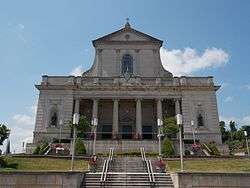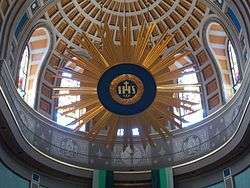Cathedral of the Blessed Sacrament (Altoona, Pennsylvania)
|
Cathedral of the Blessed Sacrament | |
 | |
  | |
| Location |
One Cathedral Square Altoona, Pennsylvania |
|---|---|
| Coordinates | 40°30′56.88″N 78°24′14.4″W / 40.5158000°N 78.404000°WCoordinates: 40°30′56.88″N 78°24′14.4″W / 40.5158000°N 78.404000°W |
| Built | 1924–60 |
| Architect | George I. Lovatt, Sr. |
| Architectural style | Baroque Revival |
| Part of | Downtown Altoona Historic District |
| NRHP Reference # | 92000946[1] |
| Added to NRHP | July 24, 1992 |
The Cathedral of the Blessed Sacrament is a Roman Catholic cathedral located at One Cathedral Square in Altoona, Pennsylvania. It is within the boundaries of the Downtown Altoona Historic District, and added to the National Register of Historic Places in 1992.[1] It is the mother church of the Roman Catholic Diocese of Altoona-Johnstown and is the seat of its prelate bishop, Most Reverend Mark Leonard Bartchak. The Cathedral of the Blessed Sacrament Pastoral staff is Rev. Monsignor Robert C. Mazur, rector, and Rev. Father Dennis Kurdziel, parochial vicar.
Pastors of The Cathedral of the Blessed Sacrament
- Rev. John Tuigg 1853–76
- Rev. John Walsh 1876–80
- Rev. Thomas Ryan 1880–83
- Most Rev. John Tuigg 1883–89
- Administrators: Nicholas O'reilly and Thomas Smith
- Rev. Edward Bush 1890–94
- Rev. Morgan Sheedy 1894–1939
- Named First Rector: 1901
- Rev. Msgr. Ildephonse Denny 1939–72
- Rev. Msgr. Thomas Madden, PA 1972–87
- Rev. Msgr. Paul Panza, PA 1987–95
- Rev. Msgr. Robert Mazur 1995–present
History

The cathedral was built between September 17, 1924 and November 13, 1960. The Cathedral's architecture is Baroque in style and capped with a classically influenced dome. The architect was George I. Lovatt, Sr. of Philadelphia, who also designed the cathedral for the Diocese of Harrisburg Pennsylvania.
History of the cathedral's construction
- September 17, 1924 – Ground is broken.
- May 30, 1926 – The cornerstone laid (25th anniversary of erection of diocese).
- 1929 – Construction comes to a halt due to the Stock Market Crash.
- September 7, 1931 – The unfinished Cathedral opens for public worship.
- Over next 28 years, Bishop Guilfoyle (the third bishop) accumulates the funds for the cathedral's completion. Bishop Guilfoyle dies before work can begin.
- Bishop Carroll (fourth bishop) begins the work but dies within a year. Work had progressed so fast, however, that his funeral was celebrated in March, 1960 in the nearly completed Cathedral.
- November 13, 1960 – Bishop McCormick formally opens the cathedral.
Located on the left and right of the cathedral's main entrance are statues of two key figures in the development of Roman Catholicism in the area:
Demetrius Gallitzin: apostle of the Alleghenies (1770–1840)
Born into a princely Russian family at the Hague, Holland, Demetrius Augustine Gallitzin, was baptized Russian Orthodox, but raised with no real faith. After his mother's religious conversion and return to her Catholic faith, Demetrius would become Catholic.On a tour of the United States before embarking on a military career, Demetrius (travelling under the name Augustine Smith) decided to become a missionary priest in this new land. Accepted by Bishop John Carroll, he was ordained in 1795 and became the first priest to receive all of his clerical orders in the United States. He came to this area on a sick call 1796 and returned a few years later to establish Loretto. He served the area for over 40 years.
John Carroll: first bishop of the United States (1735–1815)
In 1790, John Carroll became the first U.S. bishop. Carroll was ordained a Jesuit priest in 1769. He encouraged Saint Elizabeth Ann Seton to come to Baltimore and aided her in founding her first school. He was instrumental in guiding the priestly vocation of Prince Demetrius Gallitzin and assigning him to these mountains in Pennsylvania.
The baptismal font is placed at the entrance of the cathedral as a reminder of its importance for bringing each of us into the family that is the Church. Through the triple pouring of water and the words "I baptize you in the name of the Father, and of the Son, and of the Holy Spirit", Baptism frees us from sin and makes us members of the Body of Christ.
The interior

From the floor to the eye of the dome is 152 feet. At its base is written "Hoc est enim Corpus Meum. Hic est enim Calix Sanguinis Mei. Mysterium Fidei." (This is My Body. This is the Cup of My Blood. The Mystery of Faith.) The dome then rests on medallions of the four Evangelists... Saint Matthew, Saint Mark, Saint Luke, and Saint John.
Along the base of the vault of the nave are located six holy men and women, each of whom has a special connection to the Blessed Sacrament: Saint Tarsicius, Saint Thomas Aquinas, Saint Paschal Baylon, Blessed Juliana of Mount Cornillon, Saint Clare, & Saint Imelda.
Along the base of the dome and the sanctuary are also several symbols of the Eucharist: wheat, grapes, and wine, loaves, and fish, the monstrance, the chalice and host, and the pelican.

The altar is the central item in the cathedral. It is around the altar that the faithful gather to celebrate and experience the presence of Christ in the Eucharist. It is here that simple gifts of bread and wine become the very Body and Blood of Jesus Christ. The altar in the cathedral is twelve feet long. This number is significant in its association with the number of the Apostles and the tribes of Israel. Above the altar hangs a golden tester. It is intended to set the altar off.
The word cathedral is derived from a Latin word, cathedra, meaning "chair". In early Christian literature, it always conveyed the idea of authority. The Cathedral of the Blessed Sacrament, then, is not important simply because it is the largest and the most beautiful church in the diocese, but because of its character as the "cathedra" or "seat" of the bishop.
There are seven sanctuary stained glass windows that consist of The Annunciation, The Nativity, The Last Supper, The Crucifixion, The Resurrection, The Ascension, and The Crowning of Mary.
Directly below the altar in the basement, a chapel mausoleum named "the crypt chapel" was erected for the entombment of bishops for the Diocese of Altoona-Johnstown. Currently, 6 bishops and 1 rector of the cathedral are entombed in the crypt chapel, with the coat of arms erected on the crypt door. Bishop Eugene A. Garvey, Bishop John J. McCort, Bishop Richard T. Guilfoyle, Bishop Howard J. Carroll, Bishop Joseph C. McCormick and Bishop James J. Hogan are the current bishops entombed in the crypt chapel. Monsignor Thomas E. Madden, who served as rector from 1972 to 1987, is also entombed in the chapel.

The cathedral is home to an organ, built in 1931 by the old German firm of G.F. Steinmeyer and Company, Ottingen, Bavaria, Germany. The organ has 57 speaking stops with 78 ranks and 4759 pipes, made of wood, zinc and various tin and lead alloys. The largest pipes, nearly 20 feet long, with a diameter of 10 inches, dwarf the smallest pipes having a pencil-like shape and an eight-inch length. Four bellows, eight by four feet, each with three folds, furnish a sufficient wind supply for the organ. Technical details, however, do not give the organ its special importance. It is the quality of its tonal design and structure, the clarity, richness and fullness of the ensemble, the beauty and characters of the single voices, and the cohesiveness of any combination of stops which make it an inspiring instrument for both organist and listener. The organ stands below the stained glass window of Saint Cecelia, Patroness of music and musicians. The donor of this organ, Mrs. Annie C. Wolf, whose generosity made this instrument possible, and the genius of the Steinmeyer firm, have given us a means of rendering glory to God; and in a mystical sense, we pray that Christ's hands will ever be on the keyboard and His face suffused with delight as He makes all of us realize the fulfillment of the 150th Psalm: "Praise the Lord in His sanctuary". Restored in 1992, this historic organ is one of the focal points in the cathedral. In 1997, The organ was featured on The Joy of Music, with the festival choir, under the direction of Robert Long.
See also
- Cathedral of Saint John Gualbert (Johnstown)
References
- 1 2 National Park Service (2010-07-09). "National Register Information System". National Register of Historic Places. National Park Service.
External links
| Wikimedia Commons has media related to Cathedral of the Blessed Sacrament (Altoona, Pennsylvania). |
- Official Cathedral Site
- Roman Catholic Diocese of Altoona-Johnstown Official Site
- Historic American Buildings Survey (HABS) No. PA-5516, "Cathedral of the Blessed Sacrament, 1301 Thirteenth Avenue, Altoona, Blair County, PA", 10 photos, 6 data pages, 1 photo caption page
